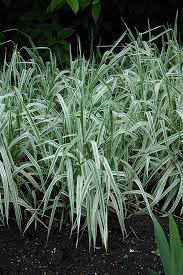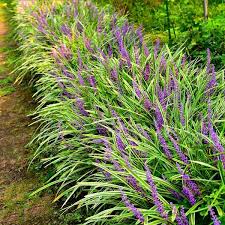Variegated Grass, scientifically named Miscanthus sinensis Variegatus, is a really pretty plant that many people like to have in their gardens. Its leaves have two colors, green and creamy white, which makes it look special. These colors make the plant interesting to look at, especially when the sunlight shines on it and creates shadows.
People like to plant variegated grass in different parts of their gardens because it can grow well in places with lots of sunlight or places with a bit of shade. It’s not too fast or too slow in growing, so it’s easy for people to take care of it and keep it a good size.
The way variegated grass grows also helps keep the soil in place and prevents other unwanted plants from growing around it. Plus, during late summer and fall, it grows these soft and pretty parts on top that sway gently when the wind blows.
Taking care of variegated grass is not too hard. You need to give it water, especially when it’s still new, and make sure the soil can drain water well. Sometimes, in the beginning of spring, you might need to trim off the parts that aren’t looking so good to help new parts grow.
So, if you want to make your garden look nice with a plant that has special two-colored leaves and can grow in different places, variegated grass could be a great choice. It’s not too much work to take care of, and it adds a special touch to your garden that you and others can enjoy all year round.
Read Also: A Guide to Growing and Caring for Little Bluestem Grass (Schizachyrium Scoparium)
Growing and Care Guide of Variegated Grass

Variegated grass, known by its scientific name Miscanthus sinensis Variegatus, is a beautiful and easy-to-maintain plant that can enhance the charm of your garden. Here’s a simple guide on how to grow and care for this lovely ornamental grass:
1. Choosing the Right Location: Variegated grass can grow well in both sunny and partially shaded areas. Choose a spot in your garden that receives at least a few hours of sunlight each day. This will help the plant develop its unique leaf colors and maintain its overall health.
2. Soil Preparation: Ensure that the soil is well-draining. You can improve drainage by adding organic matter like compost or peat moss to the soil before planting. This will help the roots grow strong and healthy.
3. Planting: Plant variegated grass in the spring or early fall. Dig a hole that’s about twice the size of the root ball and place the plant in the hole at the same depth it was growing in the container. Fill the hole with soil, press gently to secure the plant, and water thoroughly.
4. Watering: Keep the soil consistently moist during the first growing season to help the plant establish its roots. Once established, variegated grass is moderately drought-tolerant, but it’s still important to water it during dry spells.
5. Mulching: Apply a layer of mulch around the base of the plant to help retain soil moisture and suppress weed growth. Mulching also protects the roots during winter.
6. Pruning: In early spring, before new growth begins, trim back the dead or damaged foliage from the previous year. This will make way for fresh growth and keep the plant looking tidy.
7. Fertilizing: Variegated grass doesn’t need a lot of fertilizer to thrive. You can apply a balanced, slow-release fertilizer in the spring if you notice the plant’s growth slowing down or if the leaves are pale.
8. Overwintering: Variegated grass is generally hardy and can withstand cold temperatures. However, in areas with severe winters, you can help protect the plant by applying a thick layer of mulch around the base before winter arrives.
9. Dividing: After a few years, variegated grass might become overcrowded. You can divide the plant in the spring or fall by carefully digging it up and splitting the clump into smaller sections. Replant the divided sections, and they will continue to grow.
10. Enjoying the Beauty: As variegated grass grows, it will develop its unique two-tone leaves and delicate plumes that sway gracefully in the wind. Enjoy the changing colors and textures it brings to your garden throughout the seasons.
In addition, variegated grass is a delightful addition to any garden due to its captivating appearance and easy maintenance. By following these simple steps, you can successfully grow and care for this ornamental grass, enhancing the beauty of your outdoor space.
Variegated Liriope

Variegated liriope, with its scientific name Liriope muscari ‘Variegata,’ is a charming and colorful plant that can bring a touch of elegance to your garden. This plant is loved for its vibrant leaves and versatility in landscaping.
The special thing about variegated liriope is its leaves, which have a mix of colors – green and creamy white. This creates a lovely contrast that stands out in gardens and adds visual interest. When the sunlight hits the leaves, it makes the colors even more beautiful.
Gardeners enjoy using variegated liriope in different parts of their yards because it can grow well in different conditions. Whether it’s in full sunlight or partial shade, this plant can adapt and thrive. It’s not too big, so it’s easy to fit into different spaces without taking up too much room.
Taking care of variegated liriope is quite simple. It doesn’t need a lot of water once it’s established, and it can handle different types of soil. You might want to trim off any dead leaves in the spring to keep it looking neat.
One of the great things about variegated liriope is that it’s a low-maintenance plant. It doesn’t require a lot of attention, making it a good choice for people who are new to gardening. Plus, it has this bonus of producing small spikes of flowers in late summer, adding a touch of beauty to your garden.
Additionally, if you’re looking for a plant that’s easy to care for and brings a burst of color to your outdoor space, variegated liriope is a wonderful option. Its eye-catching leaves and adaptability make it a popular choice among garden enthusiasts. Whether you’re a seasoned gardener or just starting out, this plant can bring joy and elegance to your landscape with its simple yet captivating beauty.
Read Also: A Guide to Growing and Caring for Bunny Tails Grass (Lagurus Ovatus)
Uses of Variegated Liriope

Here are three good uses for variegated liriope in your garden:
1. Border Planting: Variegated liriope is an excellent choice for creating neat and attractive borders in your garden. Its colorful foliage adds a charming edge to pathways, flower beds, or around trees. The contrasting colors of the leaves can help define spaces and add a touch of elegance to your landscape.
2. Ground Cover: If you have areas in your garden that need a low-maintenance ground cover, variegated liriope can be the perfect solution. Its dense growth habit helps suppress weed growth, reducing the need for constant maintenance. Whether it’s under trees or in hard-to-mow spaces, variegated liriope can create a lush carpet of color that stays attractive throughout the seasons.
3. Container Planting: Variegated liriope is also well-suited for container gardening. Its compact size makes it an ideal choice for adding color and texture to pots and planters on your patio or balcony. You can mix and match variegated liriope with other flowering plants to create visually appealing and easy-to-maintain container arrangements.
These are just a few of the many ways you can use variegated liriope to enhance your garden. Its versatility, vibrant colors, and low-maintenance nature make it a valuable addition to various landscaping projects.
